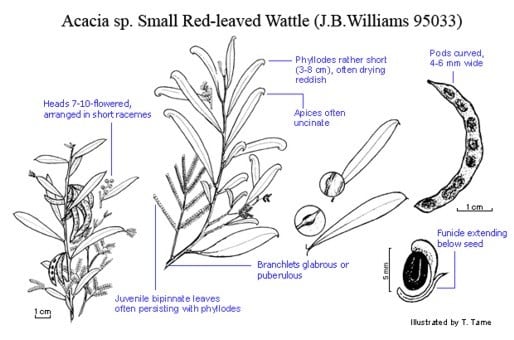Acacia sp. Small Red-leaved Wattle (J.B.Williams 95033) NSW Herbarium
WATTLE
Acacias of Australia
Family
Fabaceae
Distribution
Disjunct in N.S.W., occurring in Cathedral Rock NP near Ebor and further south in the western Blue Mtns from Cullen Bullen to Capertee.
Description
Spreading, multi-stemmed shrub 0.3–2 m high, juvenile bipinnate leaves often persistent on mature plants. Branchlets red to reddish brown, glabrous or sometimes puberulous. Bipinnate leaves: rachis 1.5–3.5 cm long, jugary and inter-jugary glands absent; pinnae 2–4 pairs, 1.5–3.5 cm long; pinnules 6–12 pairs, oblong-elliptic, 2.5–6 mm long, 1.5–2 mm wide. Phyllodes oblanceolate, acute or rounded-uncinate with a distinctly excentric mucro (innocuous or ±coarsely pungent), ±straight, 2–7 cm long, 6–17 mm wide, often drying reddish, ±glabrous; midrib central or sometimes towards upper margin; gland (2–) 5–15 mm above pulvinus, not connected to midrib by a nerve. Inflorescences racemose; raceme axes mostly 1–2.5 cm long, sparsely ±spreading-hairy; peduncles 1–3 mm long; subglabrous or minutely ±spreading-hairy; heads globular, 7–10-flowered, bright yellow. Flowers 5 –merous; sepals united. Pods narrowly oblong to linear, ±flat, straight edged or slightly constricted between seeds, 1.5–8.5 cm long, 4–6 mm wide, firmly chartaceous to thinly coriaceous, shallowly to strongly curved, glabrous. Seeds longitudinal, elliptic, c. 4 mm long, dark brown; funicle extending to below the seeds and sometimes partially encircling them.
Phenology
Flowers Sept.–Oct.
Habitat
Usually grows in dry sclerophyll forest or woodland, on fertile sandy soils, in elevated rocky locations; often found on disturbed roadsides.
Specimens
N.S.W.: Ben Bullen, 20 miles [32 km] NNW of Lithgow, E.F.Constable 7189 (NSW, PERTH); 61 km ENE of Armidale on the Ebor rd, R.G.Coveny 5670 & N.Lander (BRI, CANB, K, MEL, MO, NE, NSW, NY, PERTH, UNSW); 67 km E of Armidale at turnoff to Point Lookout from Armidale–Ebor rd, 19 Sept. 1974, J.B.Williams s.n. (MO, NSW, PERTH).
Notes
A member of the ‘Acacia microbotrya group’ and treated by B.R.Maslin, Fl. Australia 11A: 262 (2001) as a dwarf variant under A. rubida. However, apart from its generally taller stature A. rubida is most readily distinguished by its usually larger phyllodes which are often falcate, acute to acuminate and have the gland further removed from the pulvinus, generally more flowers per head, ±straight, larger pods and funicles which encircle the seeds.
FOA Reference
Flora of Australia Project
Author
B.R.Maslin
This identification key and fact sheets are available as a mobile application:
URL: https://apps.lucidcentral.org/wattle/
© Copyright 2018. All rights reserved.






